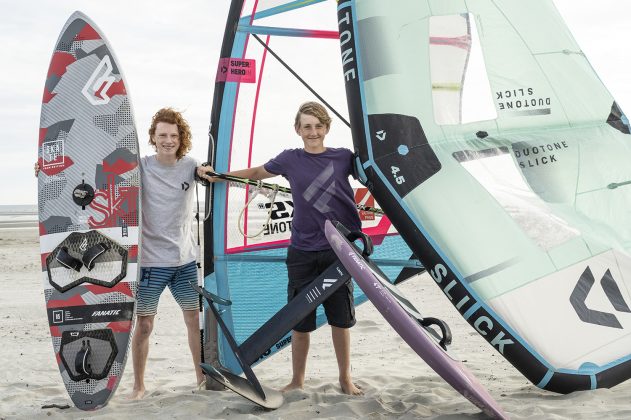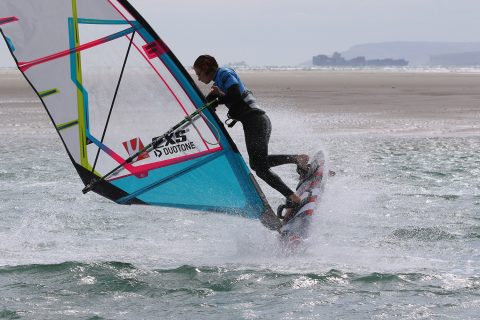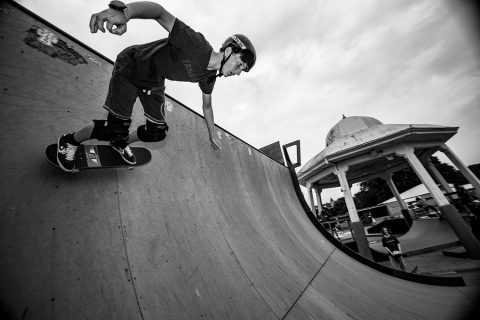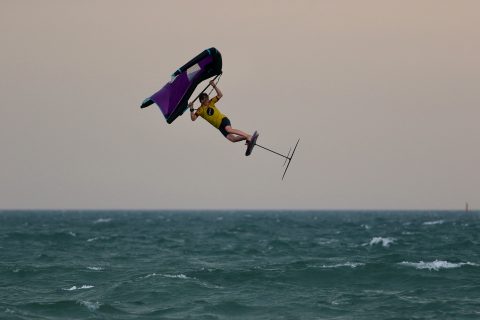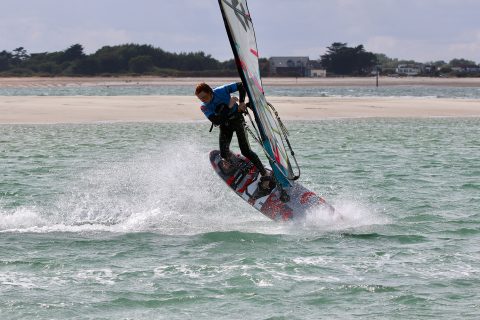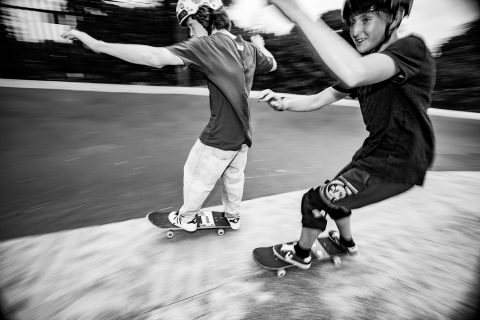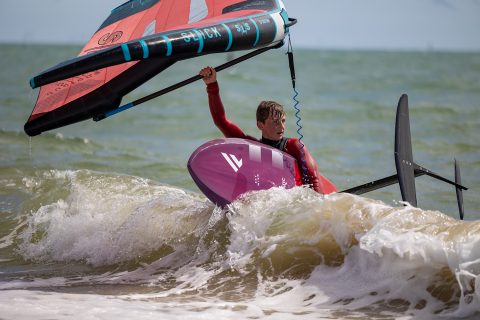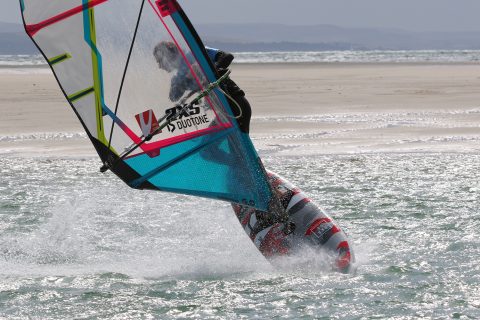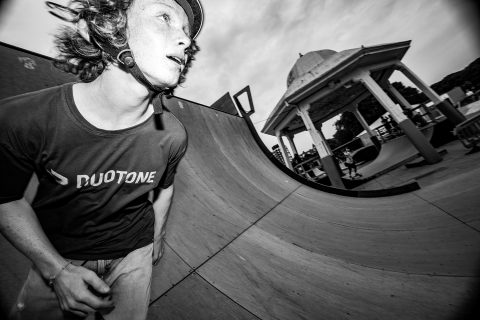YOUNG GUNS : SOUTH COAST KIDS
Freddie Sargent (15) and Hugo Dobrijevic (14), the two youngest riders of the K66 Duotone/Fanatic/Ion team, are having the time of their lives windsurfing and winging on the South Coast of England. They explain how learning to skate, surf, windsurf and wing foil all at the same time has helped them with their chosen disciplines, and their respective parents give tips on how to get your kids into windsurfing.
WORDS: Freddie Sargent, Hugo Dobrijevic, Oliver Sargent, Rachel Dobrijevic. // PHOTOS: Dave Dobrijevic, Simon Bassett 2XS, Stewart Grant.
Fast learners
Hugo: We’ve been lucky in a number of ways: we live near the sea, our parents are windsurfers and, probably most importantly, we’ve got a group of local friends who are into watersports, so we almost always have someone to share the stoke with.
Freddie: Unlike other places that you read about, where it’s always windy, the UK is a bit variable and I think we’ve made the most of that by doing complimentary sports; we have something to do in all states of wind and the skills learnt are transferable. We’re both into skateboarding, surfing and tow-foiling, which gives us a huge head start with windsurfing. Likewise, if you can windsurf, then learning to wing foil is so much easier.
- West Witterings action
Complimentary sports
Hugo: So much of learning a new trick is being able to visualise it. Skating helps you to visualise the basics of all board sports, with half-pipes simulating waves, and spin tricks simulating comparable tricks in other sports. An ‘Ollie’ on a skateboard is similar to popping on a windsurf board, so if you’re automatic with that part of a trick, it frees up your brain to focus on the next bit.
- Skate training
Freddie: Skating and watersports have their own cultures, but they’re all quite similar. Both skaters and windsurfers are really supportive when you’re trying to learn something; the older or better people help you out.
Very few parents skate (they don’t bounce off concrete so well) and so adults are sometimes a bit afraid of skate parks and the teenagers that hang around them, but they are generally very friendly and feel similar to the beach in that regard. At skateparks, you have to wait your turn to use ramps etc., so you learn to be aware of other people and to be respectful, which is a good thing; skateboarders are rarely territorial like surfers.
I think that because windsurfing and foiling are dependent on the weather, you get excited on good days. Skating is more of a constant.
- Wing session
Advice
Freddie: Focus on the prize – once you get planing in the footstraps and harness then you’ll be addicted and then learning just naturally happens. My ten-year-old sister has just started planing in the harness and Hugo’s nine-year-old brother is mastering the basics of wing foiling! A top tip would be to get a good wetsuit. It feels like a waste of money when kids often grow out of them within a year, but if you really want to get your kids into watersports, they’re much more likely to enjoy it and stick at it if they’re not freezing. Both Hugo and I are lucky living between West Wittering and Hayling Island. 2XS’s centre at West Wittering is a perfect place to learn, but you have to go at the right time of the tide and direction of wind (ask the 2XS shop, if you don’t know).
Hugo: Once you fly for the first time foiling, you want to do it forever. Up until that point, learning is difficult and frustrating, so you have to push through that. I spend a lot of time on the water off Hayling. On a good day there are loads of kids down there; it’s so much more fun to push for big airs or tricks if you know that your mate is watching!
- Freestyle action
Favourite sport
Freddie: Nothing beats a good wavesailing day, but any day that you land a new trick is a good day!
Hugo: Wing foiling for the big air tricks.
Next big trick
Freddie: Has to be working on my Flakas.
Hugo: I am trying 720s on my wingfoil kit.
- Skate fun
Competitions
Freddie: I haven’t started competing yet on a windsurfer, but did my first UKWA wing foil event (with Hugo) recently.
Hugo: I’m competing at wing foil slalom and freestyle comps and am stoked with the opportunity to represent K66 at events. At Lee on Solent in July, I came 3rd in the youths.
- Heading out
Starting age
Freddie: When I was eight, but I only started to get really into windsurfing when I was about ten.
Hugo: Aged 4! My dad is a sailmaker at Dynamic Sails and made me a 0.5m windsurfing rig using a tiller extension for a mast and I was on his 80-litre wave board.
Favourite spot
Freddie: West Wittering has great waves at high tide and flat water for freestyle at low tide.
Hugo: Wing foiling off Hayling Island; the waves there can be insane off the sandbar, they peel for ages and are perfect for foiling.
- Windsurf action at Witterings
Parent tips
Oliver Sargent (Freddie’s dad): My theory is that children will be interested in the same things as their parents until about the age of 12, so get in there early and try to get them hooked before it’s too late. Teaching your own children is really hard, so if possible, get someone else to do it. Mine enjoyed doing courses, partly because there are other people to learn with, and partly because the instructors are great at making it fun in a way that parents can’t. This, I suspect, is even more important if you’re children are over 12 when starting. Arranging group trips to the beach is a logistical headache, but when they can sail with friends, they learn much quicker and push each other. Give them a subscription to Windsurf Magazine to keep them inspired!
To get kids planing, they need to be on a board that planes easily, ideally a light freeride board that’s big enough to easily uphaul. Freddie learnt on an old slalom board that was 120-litres. You also need to be out in enough wind (15-20 knots is ideal) and a big enough sail to hold your weight. If you find some flat water, that’ll make it much easier too. To be comfortable in planing wind, they should first be able to sail upwind and downwind (on purpose) in light wind When the windy day arrives, before going on the water, I recommend (although my kids all complained about it) spending 30 minutes on the beach, with the fin taken out of the board, practising with the sail. It doesn’t take long to learn to lean against the wind and balance by sheeting in and out. Learning this on the beach is so much quicker than trying to learn it on the water. It’s worth trying this with a harness, even if they’re not going to use one on the water. Once they can sit comfortably in the harness with no weight on their hands (they can practice taking off one hand at a time) and they can lower themselves to the ground and ‘waterstart’ back up again, then they’re ready for the next level! Bear in mind that being hooked in on the beach puts them at risk of catapulting onto the ground, so make sure that there is an adult holding the uphaul to protect against this. On the water in stronger winds, the sail will be heavier than normal, but tell them to not rush pulling up the sail; just lean against it until it’s in the right position (when it starts to feel lighter), and then pull. To get planing, they’ll need to lean against the sail as much as possible and try to get their feet back on the board (back foot between the straps, and the front foot just in front of the front strap) and sail across the wind (not upwind or downwind). However, they’ll get the most speed when going slightly downwind, so they should be prepared to do a bit of sailing/walking upwind between speed runs. When my three children were ready, I took them on a downwinder; we launched from an upwind area of the harbour and my wife picked us up downwind. This meant that they could focus on the fun part of trying to go fast rather than staying upwind.
- Young guns
Rachel Dobrijevic (Hugo’s mum):
Firstly, get out there yourself and get involved. Children are far more likely to take part in watersports if their family is doing it too. Long before Hugo arrived his Dad impressed me with his wavesailing and forward loops and before I knew it I was purchasing an old Bic Techno and a 5.0m rig on Ebay. Things quickly progressed and soon I was mixing it up in the waves off Bracklesham on a much smaller Goya wave board and 4.2 sail, trying my own tricks in the surf and often some unplanned long swims! It has definitely helped that Hugo has always had two parents taking part in boardsports to look up to and it has kept our family unit close, as even nowadays we go to the beach as a family and share the stoke on the water whooping and yelling as we pass each other, and all of us keep pushing our limits and trying out new things.
You can certainly invest in lessons and whilst I know that works for some, we have always found that our kids like to learn things by doing them independently, on their own terms and with a lot of practice. We just make sure that they have access to good equipment and plenty of opportunities to get to the beach and on the water at weekends, school holidays and even after school sometimes.
We are all really into foiling now, it started with Dave (Hugo’s Dad) getting a wind foil in 2020 and a light 5.4m sail; he loved it and instantly started gybing and jumping it. Hugo and I would then stand on the beach, each of us desperate to get the next turn on the kit before I eventually bit the bullet and bought my own set of kit. Even Felix (9) has been foiling as a passenger on the wind foil! Once you have tried wind foiling, it’s very hard to go back to low-rider windsurfing, the buzz of flying over the water is just so addictive!
Last piece of advice – keep it fun, it should never ever feel like a chore, windsurfing is hard enough to learn on a good day! If they seem to be struggling or not enjoying it, call it a day, buy them an ice cream and come back to it another time – with friends and family to enjoy it with!


